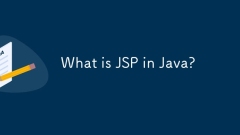 Article Tags
Article Tags
-
All
-
web3.0
-
Backend Development
-
Web Front-end
-

 All
All
-

 JS Tutorial
JS Tutorial
-

 HTML Tutorial
HTML Tutorial
-

 CSS Tutorial
CSS Tutorial
-

 H5 Tutorial
H5 Tutorial
-

 Front-end Q&A
Front-end Q&A
-

 PS Tutorial
PS Tutorial
-

 Bootstrap Tutorial
Bootstrap Tutorial
-

 Vue.js
Vue.js
-
-
Database
-
Operation and Maintenance
-
Development Tools
-
PHP Framework
-
Common Problem
-
Other
-
Tech
-
CMS Tutorial
-
Java
-
System Tutorial
-
Computer Tutorials
-
Hardware Tutorial
-
Mobile Tutorial
-
Software Tutorial
-
Mobile Game Tutorial

What is JSP in Java?
JSP,orJavaServerPages,isaJavawebtechnologythatenablesdeveloperstocreatedynamicwebcontentbyembeddingJavacodewithinHTML,allowingfortheseamlessintegrationofserver-sidelogicandpresentation;whenauserrequestsaJSPpage,thewebserverautomaticallyconvertsitinto
Aug 25, 2025 am 05:24 AM
What are the best practices for handling null values in Java?
Return empty collection, Optional or default value instead of null; 2. Use Optional as the return type that may have no results; 3. Verify parameters with Objects.requireNonNull() and cooperate with @NonNull and other annotations; 4. Use secure navigation or Optional chains to avoid nested empty checks when necessary; 5. Reduce null fields through initialization and immutable objects; 6. Use static analysis tools to combine annotations to discover null problems in advance; 7. Avoid abuse of null and replace them with meaningful default values; Summary: APIs that make null rare and explicit should be designed to handle them as soon as possible, fail quickly, and use tools to avoid runtime exceptions.
Aug 25, 2025 am 05:18 AM
Client remotely executes server-side GUI applications: Download and start tutorial
This tutorial details the complete process of how a client downloads and runs a GUI application locally from the server. Through Java code examples, we will learn how to use URL and file operations to download JAR packages and use ProcessBuilder to launch the GUI application in the client environment, while providing important security and version management considerations.
Aug 25, 2025 am 05:15 AM
What does the static keyword signify in Java?
StaticinJavabelongstotheclass,notinstances,andenablessharingacrossallobjectswithoutinstantiation.1.Staticvariablesaresharedamongallinstances,withonlyonecopyexisting,suchasstaticintcountinaCounterclassthatincrementswitheachobjectcreation.2.Staticmetho
Aug 25, 2025 am 04:41 AM
Building Event-Driven Systems in Java with Apache Kafka
To build an event-driven system using Java and ApacheKafka, you must first master the core concept of Kafka and implement producers and consumers in steps. 1. Understand the role of topics, partitions, producers, consumers, consumer groups and Brokers to achieve service decoupling. 2. Introduce kafka-clients dependencies in Java projects, write producer code to send events to specified topics, such as user login messages. 3. Create consumer subscription topics, get messages through polling and process business logic, and support horizontal scaling. 4. Follow best practices: Use SchemaRegistry to manage event structure, ensure consumer idempotence, process failed messages to dead letter queues, monitor consumption lag, and reasonably design partitions
Aug 25, 2025 am 03:56 AM
Spring Data JPA projection: efficient query and partial data mapping
This article explores in-depth how to use Spring Data JPA's Projections functionality in Spring Boot applications to efficiently select specific fields from the database and map to custom interfaces or DTO objects instead of complete entity classes. This solves the ConversionFailedException problem that occurs when directly mapping part of the query results (such as Object[]) to an entity, thereby optimizing the performance and flexibility of data retrieval.
Aug 25, 2025 am 03:36 AM
The Difference Between `String`, `StringBuilder`, and `StringBuffer` in Java
Stringisimmutableandthread-safe,makingitsuitableforconstanttextandscenariosrequiringnomodification;2.StringBuilderismutableandnotthread-safe,offeringhighperformanceforsingle-threadedstringmanipulations;3.StringBufferismutableandthread-safeduetosynchr
Aug 25, 2025 am 03:06 AM
How to use constructors in Java
Java constructor is a special method used to initialize objects. It must be the same name as the class name and has no return type; 1. The constructor is automatically called when the object is created and is used to set the field initial value; 2. It is divided into default constructor (no parameters, automatically provided by Java), custom parameterless constructor and parameterized constructor; 3. It supports constructor overloading, allowing multiple constructors with different parameter lists in the same class; 4. The constructor chain call can be implemented through this() to reduce duplicate code; 5. After defining any constructor, Java no longer provides the default parameterless constructor; 6. The constructor can be used to verify input, ensure the validity of the object state, and improve the robustness of the class. Correct use of constructors ensures that the object is always in a consistent initial state
Aug 25, 2025 am 02:33 AM
What is the finally block in Java?
ThefinallyblockinJavaalwaysexecutesafterthetry-catchblock,regardlessofwhetheranexceptionoccursorareturnstatementisencountered,makingitidealforcleanuptaskslikeclosingfilesorreleasingresources;itrunsevenifanexceptionisthrownandnotcaught,orifamethodexit
Aug 25, 2025 am 01:50 AM
What is JDBC in Java?
JDBC,orJavaDatabaseConnectivity,isastandardAPIthatenablesJavaapplicationstointeractwithrelationaldatabaseslikeMySQL,PostgreSQL,Oracle,andSQLServerbyactingasabridgebetweenthem.ThekeycomponentsincludeDriverManagerformanagingdatabasedriversandestablishi
Aug 24, 2025 pm 03:04 PM
How to use a List in Java
ChooseArrayListformostusecasesduetobetterperformance,orLinkedListforfrequentinsertions/deletions;2.Addelementswithadd(),accesswithget(),andchecksizewithsize();3.Modifyelementsusingset()andremoveelementsviaremove()byindexorvalue,avoidinginvalidindexes
Aug 24, 2025 pm 02:00 PM
How to create a custom annotation in Java
Definition annotations Use the @interface keyword to create custom annotations and set elements and their default values; 2. Use @Target, @Retention and other meta annotations to control the applicable goals, retention policies and other behaviors of annotations; 3. Apply custom annotations on program elements such as classes and methods, and use full parameters or abbreviations; 4. Read annotation information at runtime through reflection, and be sure to use RetentionPolicy.RUNTIME retention policy; custom annotations enhance the code function through metadata, and combine reflection to achieve flexible runtime processing, and end completely.
Aug 24, 2025 pm 01:54 PM
The Ultimate Guide to Java Interview Questions for Senior Roles
SeniorJavainterviewstestdeeptechnicalexpertise,requiringmasteryofconcurrency,JVMinternals,systemdesign,advancedlanguagefeatures,andSpring.2.Forconcurrency,understandsynchronized,ReentrantLock,JMM,andtoolslikejstackandjmh,andproviderealexamplesofreduc
Aug 24, 2025 pm 01:41 PM
How to create a scheduled task in Java?
UseScheduledExecutorServiceforschedulingtasksinJava,asitsupportsthreadpoolingandbettererrorhandling.2.CreateaScheduledExecutorServiceinstanceusingExecutors.newSingleThreadScheduledExecutor().3.DefinethetaskasaRunnabletobeexecuted.4.Schedulethetaskusi
Aug 24, 2025 pm 01:40 PM
Hot tools Tags

Undress AI Tool
Undress images for free

Undresser.AI Undress
AI-powered app for creating realistic nude photos

AI Clothes Remover
Online AI tool for removing clothes from photos.

ArtGPT
AI image generator for creative art from text prompts.

Stock Market GPT
AI powered investment research for smarter decisions

Hot Article

Hot Tools

vc9-vc14 (32+64 bit) runtime library collection (link below)
Download the collection of runtime libraries required for phpStudy installation

VC9 32-bit
VC9 32-bit phpstudy integrated installation environment runtime library

PHP programmer toolbox full version
Programmer Toolbox v1.0 PHP Integrated Environment

VC11 32-bit
VC11 32-bit phpstudy integrated installation environment runtime library

SublimeText3 Chinese version
Chinese version, very easy to use

Hot Topics
 1649
1649
 276
276




